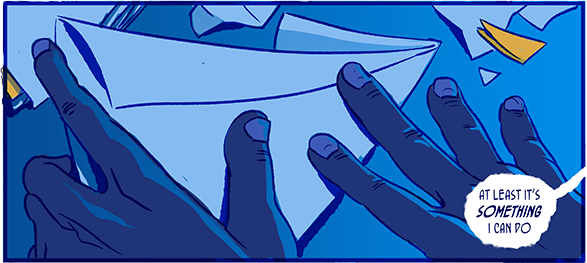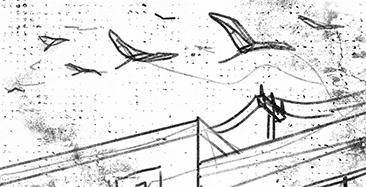

chimiri
the aerials
prefix chi suffix miri
honetts scapharinx
physical appearance
The nimble chimiri /ˈtʃaɪˌmɪri/ is a lightweight and light-colored origami stranger with a variable paper,० eye,१ and tail length,५ all of which function to give it the high illusion of individuality.
० from newsprint to patterned origami sheets.
१ from crayon scribbles to fingerprint-eyes.
५ from a dart, to a ribbon.
Though the chimiri's body is paper-like in every other way,১ rainwater does not permeate its surface, which allows it to survive even the most tumurrenous storms.꒡ This being said, all other forms of water⼎ lead to as fatal a result as would be expected.丫
১ Including fragility; though it escaped the predator strangers' attentions.
꒡ But not the flood.
⼎ Particularly, floodwaters.
丫 It soaks and breaks apart.
In its vocalizations, the chimiri is pleasant, if brief. Its allitinean tones, with all their virulence, could be mistaken for the chipper trills of a curious songbird.
a sing-song chirp that starts and stops abruptly.

generation within tall-towered cities
The chimiri appears only near tall buildings. In the air around the tower-tops, it starts as a tiny sliver, which expands as it descends. By the time it reaches a towerside upon which to cling, the minuscule yet dextrous hands that grip without effort the glass or steel or plasti-polywood are fully formed, and so are the folds of its body creased tight and mature.
The chimiri does not generate within two hundred and sixty-two feet of a condroni tower (nor does it willingly travel within this diameter during its life).
behaviour
The chimiri possesses a discreet and routine demeanor. In its daily patterns, it climbs building-sides above all else, scaling towers with a sciurian tingericity, and unimpeded by winds.
Once it reaches a high enough elevation, it detaches itself and glides downward and forward, as would a paper plane, until it comes to settle on another tower, or (rarely) the same tower again.
Possessing incredible dexterity, there is no fall that can harm the chimiri, and no surface that the stranger's small feet cannot affix to. It is even capable of climbing upside-down.
The chimiri keeps a wide territory spanning dozens of blocks in diameter, and will not encounter another of its strain unless such proximity is enforced. Strictly aerial or turriminous, it spends no time within seventy-five feet of the ground and ascends if displaced into such depths.
interactions with sensitives
Under most circumstances, the chimiri has no interest in sensitives. Unless trapped, it can only be observed through windows, or from a great distance. When trapped, the chimiri grows docile, if vaguely impatient, as though waiting for an inevitable release. It does not resist handling, and when held, rotitates its legs with listless autocholetry. And, should it receive mercy on the part of its captor, the chimiri returns to its normal routine.
A chimiri takes fascination only in a sensitive's murder, and only when such an event can be seen through a window. Whether the murder is done via gun or strangulation, all chimiri within the line of sight, no matter how far, congregate towards the scene. There, they pound their small fists on the window, and disperse when shooed away, or after the murder has culminated.
unfolding the chimiri
A sensitive can easily unfold a chimiri's paper architecture, though only the first fold can be refolded; anything beyond this proves fatal for the small stranger. Furthermore, as the chimiri is unfolded, it becomes more difficult to refold, until this goal can no longer be accomplished at all. Its odor becomes more copperant with each uncrease.
Its dissembled corpse, though warped and crumpled, remains roughly square. Its outer and inner surface do not differ. Once unfolded, a chimiri's remains reek of blood until burnt to ash.
relation to culture
During the partisan span, rumors about certain sensitives being able to create chimiri take hold in certain cities. The method varies - in some cities, a sensitive must unfold one thousand chimiri, while in other cities, they must fold one thousand failed chimiri while reading a specific poem.
Though concrete proof of the method does not materialize, as time passes, there truth behind the rumor does become apparent. Indeed, as the years and ages stretch on, the ability to create a chimiri becomes a way of identifying sensitive candidates for clandestine organizations - sometimes forcefully.
aging and death
The chimiri reaches the end of its life without signs of aging. During its final week of life, it becomes more daring in its gliding, and displays a far greater skill than previously shown, soaring in loops, weaving between buildings, and plummeting downward, only to be lifted aloft at the last second. Shedding their usual asociality, nearby chimiri will join such an individual. As they fly, flocks grow to masses potentially numbering in the hundreds.
The chimiri always dies mid-glide. Its body becomes simplified and its legs fold inwards. By the time it is out of its usual flying range, it cannot be distinguished from an origami airplane, and crumples up when it hits the ground. Its discarded corpse bears no further distinction from paper.





